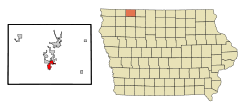Milford, Iowa
| Milford, Iowa | |
|---|---|
| City | |

Welcome sign on U.S. Highway 71
|
|
 Location of Milford, Iowa |
|
| Coordinates: 43°19′37″N 95°9′3″W / 43.32694°N 95.15083°WCoordinates: 43°19′37″N 95°9′3″W / 43.32694°N 95.15083°W | |
| Country |
|
| State |
|
| County | Dickinson |
| Area | |
| • Total | 2.29 sq mi (5.93 km2) |
| • Land | 2.28 sq mi (5.91 km2) |
| • Water | 0.01 sq mi (0.03 km2) |
| Elevation | 1,440 ft (439 m) |
| Population (2010) | |
| • Total | 2,898 |
| • Estimate (2012) | 2,954 |
| • Density | 1,271.1/sq mi (490.8/km2) |
| Time zone | Central (CST) (UTC-6) |
| • Summer (DST) | CDT (UTC-5) |
| ZIP code | 51351 |
| Area code(s) | 712 |
| FIPS code | 19-52095 |
| GNIS feature ID | 0459076 |
Milford is a city in Dickinson County, Iowa, United States. The population was 2,898 at the 2010 census. The town includes many businesses related to its location in the Iowa Great Lakes region and is often referred to as the southern gateway to the Iowa Great Lakes.
The Iowa Great Lakes Area was settled in the 1850s. It attracted many colonists because of the rich black soil, water from the lakes, and an abundance of wild game and fish. As the population increased at these times, there was a need for a good flouring mill because the nearest mills were those in Mankato, Minnesota and Fort Dodge, Iowa. In 1861, there was an attempt to build one on Mill Creek, at the outlet of the Great Lakes but the attempt was abandoned after the Dakota-U.S. War of 1862 and the extremely low water level that year. In 1868 one was successfully built, and sawmill was built and put into operation in 1869. The mills began to attract many customers, and the small community began to grow around Old Town. In 1870, the company that operated the mill bought a section of land northwest of Old Town and laid out a plan for the town of Milford.
On March 14, 1892, the first Town Council meeting was held. Some buildings were moved from Old Town to New Town and many more businesses and residences were constructed. In 1921, the U.S. flag was flown at the new city hall for the first time and that year a vote approved to pave Okoboji Avenue (Main Street of Milford). The Milwaukee rail line which ran through Milford supplied the town with mail, groceries, clothing, lumber, coal, and machinery before automobiles could get to the Great Lakes. Two passenger trains made daily trips from Des Moines to Spirit Lake, as well as another from Spencer. Until 1910, excursion trains came to the Lakes Area from Des Moines, Algona, and other towns on weekends and holidays. The last passenger train left Milford for Spencer in 1951. The last freight train left Milford for Spencer in 1976. The tracks were dismantled in 1978 and later became a part of the Iowa Great Lakes Recreational Trail.
...
Wikipedia
